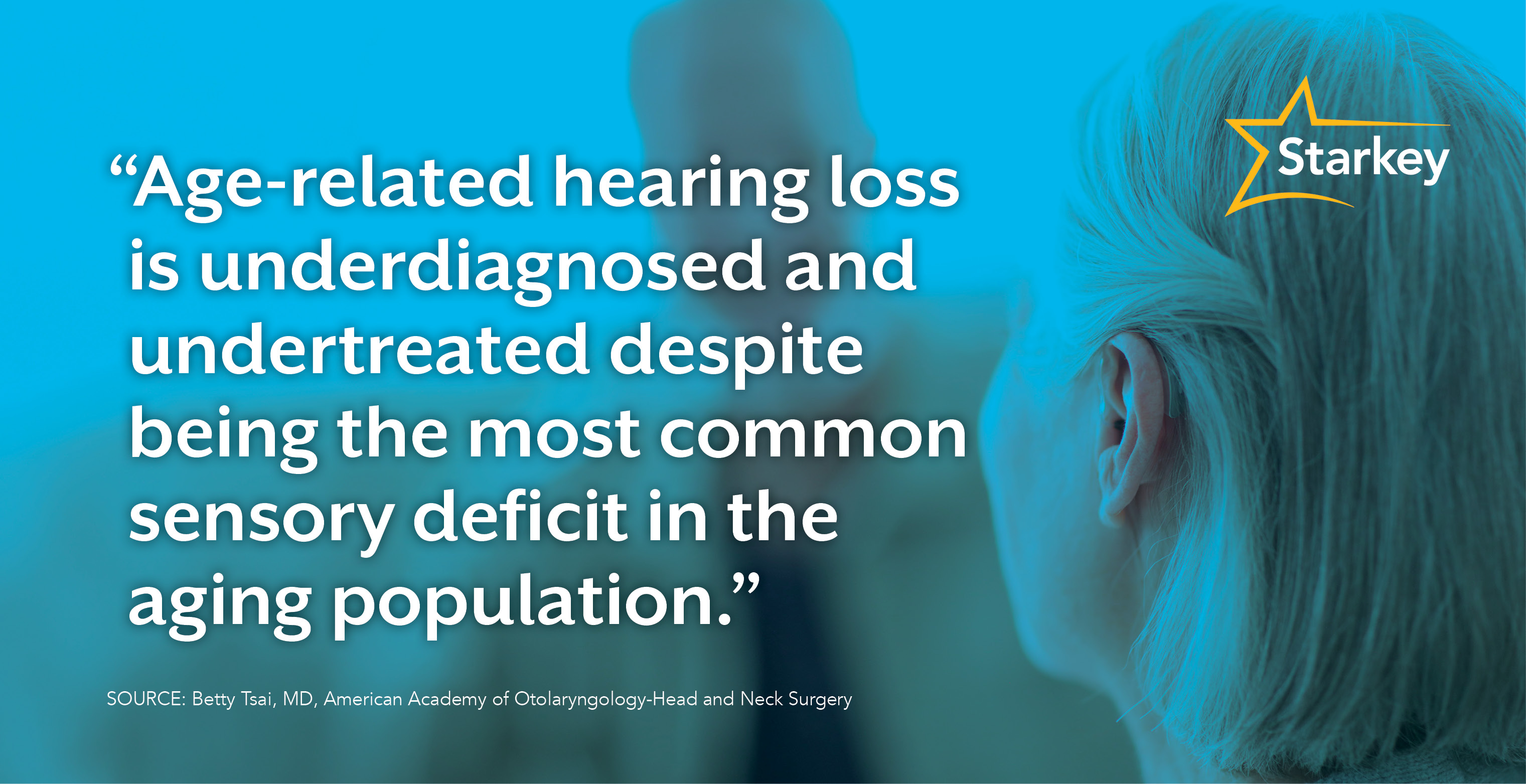Age-related hearing loss (ARHL)—or the gradual loss of hearing in both ears as we age—is far from uncommon, affecting 1 in 3 adults ages 65–74. But even though this condition (also known as presbycusis) is the most prevalent sensory deficit for aging adults, who would have guessed that it is both underdiagnosed and undertreated?
Regular hearing exams not only are the first step in helping to prevent the long-term detriments of hearing loss, such as dementia, but also play an immediate role in the early intervention of ARHL. This is important because ARHL is often difficult to detect, due to its gradual onset. As a result, people may not even realize they have hearing loss until it is further along and more challenging to treat.
Fortunately, it was today’s hearing fact that prompted the American Academy of Otolaryngology-Head and Neck Surgery to develop and publish the Clinical Practice Guideline: Age-Related Hearing Loss (CPG).

This detailed protocol offers healthcare providers evidenced-based recommendations for screening and managing ARHL, while educating them on how to communicate with their patients (aged 50 and up), according to the CPG Development Group Chair, Betty S. Tsai Do, MD.
Before we get into the recommendations, it’s important to begin with the core message behind the CPG:
The guidelines recommend that all patients aged 50 and up should be screened for hearing loss. Why? Because identifying hearing loss early and taking applicable next steps can help diminish the impact of the associated risks of ARHL. Per the CPG, these include:
- Decreased ability to communicate
- Dementia
- Depression
- Cardiovascular disease
- Falls
- Lower household income
- Unemployment
- Increased social and emotional isolation
With the numerous detriments ARHL poses to our communication and overall quality of life, it’s important to understand how the American Academy of Otolaryngology-Head and Neck Surgery is trying to change these outcomes through their recommendations for healthcare professionals in the CPG.
(View the “Plain Language” version for patients and caregivers here.)
Guidelines for screening and treating age-related hearing loss
Here is a basic summary of the recommendations (or “Key Action Statements”) the CPG advises for healthcare professionals, and in the order they should be performed.
Screen for hearing loss, rule out other conditions
Professionals are first advised to screen us for hearing loss, which includes examining our ears and assessing any hearing loss history. This can help them determine if any hearing issues should be solved potentially by medicine, surgically, or by hearing aids.
If the screening suggests we have hearing loss, the CPG recommends that our ears be checked to verify if any current conditions we may have could be causing our hearing loss. This involves examining the ear canal and tympanic membrane for abnormalities.
Once we know whether our hearing loss is age-related (or other), the CPG advises the professional to speak to us about the things in our lives that may factor into a hearing loss solution, including our circumstances, our preferences for hearing intervention, and any barriers that could affect the success of our treatment. This can help them determine the best course of treatment for our needs and ensure the best overall outcome.

Hearing test, patient counseling
The next guideline—which is strongly recommended—is to undergo a hearing test.
From the audiogram (or result of the hearing test), the professional can determine:
- the type of hearing loss we may have (i.e. asymmetric, conductive or mixed, poor word recognition, etc.)
- the degree of our hearing loss
- which ear(s) the hearing loss affects
- what sounds we may be missing
From there, the professional is advised to evaluate and treat our hearing loss. This begins with counseling us (and our loved ones) on the impact of hearing loss, on communication strategies, and on assistive listening devices that may be of help.

Fit hearing aids, plan follow-ups
Next, the professional is strongly recommended to fit us with hearing aids to treat our ARHL.
They are also advised to schedule follow-up exams within the year to ensure the hearing aids are helping us improve our hearing, meet our communication goals, and quality of life, and then pursue appropriate solutions as needed.
Regardless of any hearing loss found, the CPG specifies getting our hearing checked every three years as a best practice.
Why wait? Be proactive with your hearing health
While the CPG is a positive development towards earlier identification and treatment of age-related hearing loss, we should still feel empowered to take control of our hearing health ourselves.
Here are two ways we can be proactive about getting our hearing checked for ARHL and treated if need be:
Option 1: Tell our physician about hearing concerns
Whether we think we may have hearing loss (of any type) or even if we’re unsure, we should tell our physician. They can refer us to a licensed hearing care professional who will have the equipment and expertise to evaluate our hearing and counsel us through treatment options, if needed.
Option 2: Visit a hearing care professional
Since experts recommend having our hearing screened every three years once we’re 50, we should definitely feel empowered to make it part of our annual health checks. Hearing evaluations are simple and pain-free, and can easily be set up with a local hearing care professional.
For a head start, simply type your zip code in here to generate a list of local hearing care professionals who you can reach out to.
